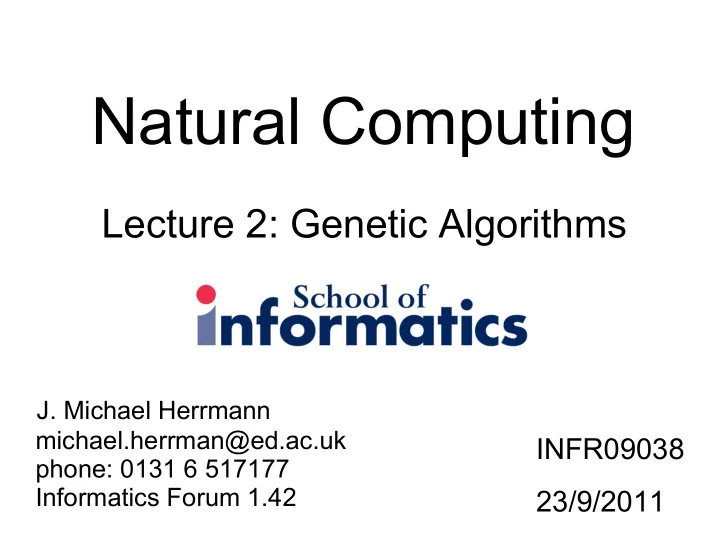

Natural Computing Lecture 2: Genetic Algorithms J. Michael Herrmann michael.herrman@ed.ac.uk INFR09038 phone: 0131 6 517177 Informatics Forum 1.42 23/9/2011
Meta-heuristic algorithms Similar to stochastic optimization Iteratively trying to improve a possibly large set of candidate solutions Few or no assumptions about the problem (need to know what is a good solution) Usually finds good rather than optimal solutions Adaptable by a number of adjustable parameters http://en.wikipedia.org/wiki/Metaheuristic
1. Chapter Genetic algorithms
An early example of an evolutionary algorithm Start Experimental contour optimization of a supersonic flashing flow nozzle Evolution (1967-1969) Hans-Paul Schwefel Result More recent work: “List of genetic algorithm applications” at wikipedia.org
Paralipomena Theory of natural evolution Genetics, genomics, bioinformatics The Philosophy of Chance (Stanislaw Lem, 1968 ) Memetics (R. Dawkins: The Selfish Gene , 1976) Neural Darwinism -- The Theory of Neuronal Group Selection (Gerald Edelman, 1975, 1989) (artificial) Immune systems Evolution of individual learning abilities, local heuristics Computational finance, markets, agents
Genetic Algorithms global search heuristics technique used in computing find exact or approximate solutions to optimization problems Applications in Bioinformatics Phylogenetics Computational science Engineering Robotics Economics Chemistry Manufacturing Mathematics Physics
The Golem Project Hod Lipson & Jordan B. Pollack (2000)
Recent scientific activity in MHA “Genetic algorithms” “Particle swarms” Source: Google scholar
Optimal assignment problem (OAP) Job 1 , Job 2 ,… , Job m IVR Wednesday 4:10 - 5pm 4.07 Appleton Tower
Tutor A, Tutor B, Tutor C, …
* * *
Job 1 2 3 4 5 6 7 8 9 10 Tutor Job 1 2 3 4 5 6 7 8 9 10 Tutor
A Simple Genetic Algorithm Selection (out of n solutions, greedy type): − Calculate Σ i f S (Job i , Tutor i ) for each solution S − Rank solutions − Choose the k best scorers (1 ≤ k ≤ n ) Breeding (Mixing good solutions): − take a few of the good solutions as parents − cut in halves, cross, and re-glue (see next slide) Mutation: − generate copies of the mixed solutions with very few modifications − e.g. for k=n/2 : two “children” for each of them
Recombination and Mutation ABCABC DDEE ABCABCDDEE ABCABCDCBA BAEDCA DCBA BAEDCADCBA BAEDCADDEE
AEBCABDCCE AEBDABDCCE AEBCABDDCE
Towards a Canonical GA Numerous variants of GAs in applications The canonical GA highlights the principles why GAs work Darrell Whitley (1989) The GENetic ImplemeTOR A heuristic fitness function is often not a good measure of any “exact fitness”: Ranking introduces a uniform scaling across the population (evaluation) Direct control of selective pressure (improvement) Efficient coverage of the search space (diversity) see: D. Whitley: A genetic algorithm tutorial. Statistics and Computing (1994) 4, 65-85
Conventions old population selection intermediate population one generation recombination mutation new population An individual is a string (genotype, chromosome) Fitness values are replaced by ranks (high to low) Fitness = objective function = evaluation function
Paralipomena Theory of natural evolution Genetics, genomics, bioinformatics The Philosophy of Chance (Stanislaw Lem, 1968 ) Memetics (R. Dawkins: The Selfish Gene , 1976) Neural Darwinism -- The Theory of Neuronal Group Selection (Gerald Edelman, 1975, 1989) (artificial) Immune systems Evolution of individual learning abilities, local heuristics Computational finance, markets, agents
Genetic Programming (GP) Evolutionary algorithm-based methodology inspired by biological evolution Finds computer programs that perform a user-defined task Similar to genetic algorithms (GA) where each individual is a computer program Optimize a population of computer programs according to a fitness landscape determined by a program's ability to perform a given computational task.
Evolutionary Computation (EC) Genetic algorithms: Solution of a problem in the form of strings of numbers using recombination and mutation Genetic programming: Evolution of computer programs Evolutionary programming: Like GP, but only the parameters evolve Evolution strategies: Vectors of real numbers as representations of solutions
Natural Computation (NC) Evolutionary Computation Artificial immune systems Neural computation Amorphous computing Ant colony optimization Swarm intelligence Harmony search Cellular automata Artificial life Membrane computing Molecular computing Quantum computing
Course organization Tuesday & Friday 15:00 – 15:50 at BSq LT1 LT1 Assignments: two assignment together worth 30% (10% + 20%) of the course mark, to be handed in at the end of Week 5 and the end of Week 9. on 27 Oct / 24 Nov (both Thursdays 4pm) Exam: worth 70% of the course mark, taken at the end of Visiting students can take the exam at the end of Semester 2. Semester 1. michael.herrmann@ed.ac.uk phone: 0131 6 517177 Informatics Forum 1.42 Literature for this part: Melanie Mitchell: An Introduction to Genetic Algorithms. MIT Press, 1996. Xin-She Yang: Nature-Inspired Metaheuristic Algorithms. Luniver Press 2010 Simulation: math.hws.edu/eck/jsdemo/jsGeneticAlgorithm.html
Recommend
More recommend